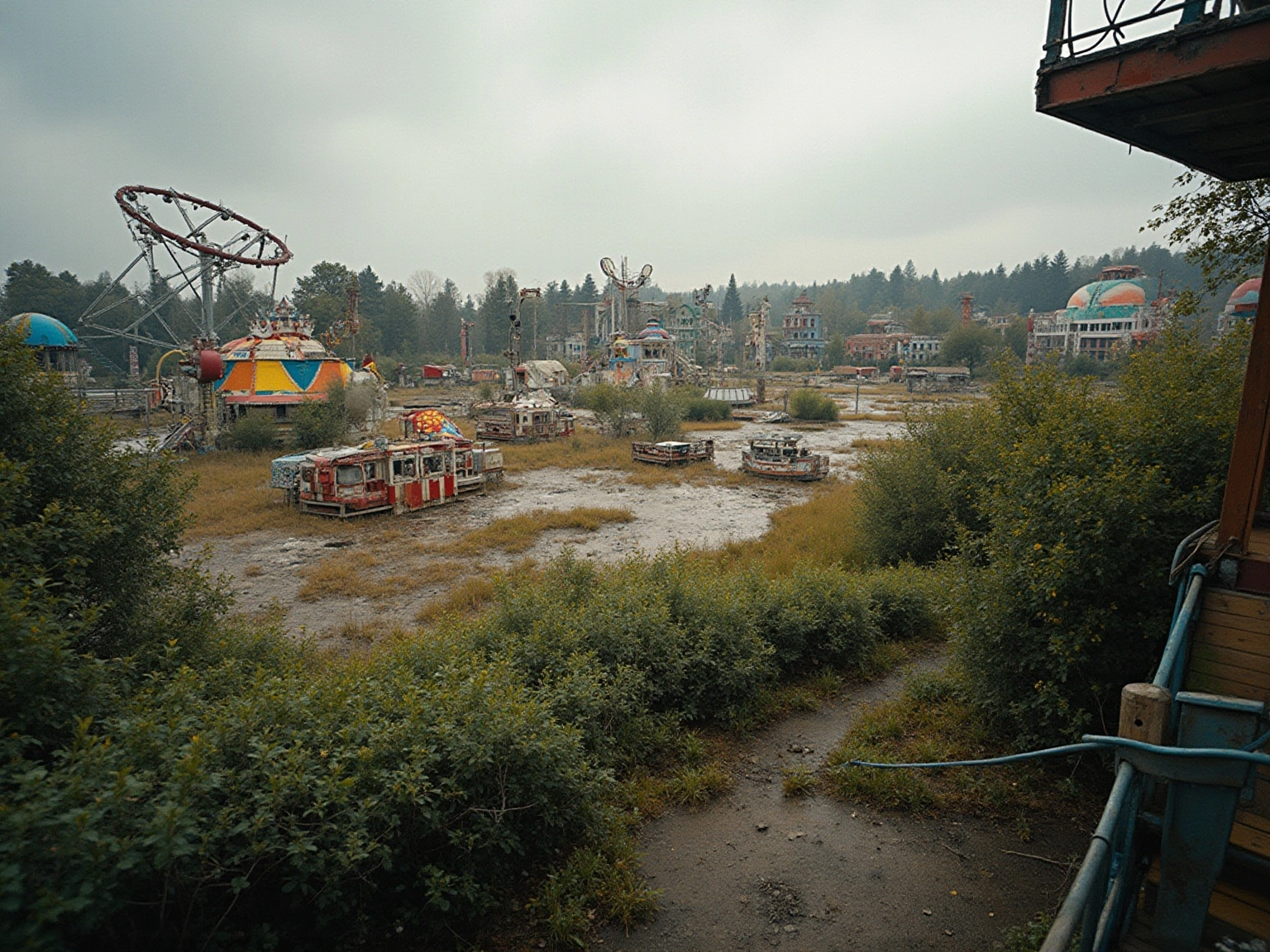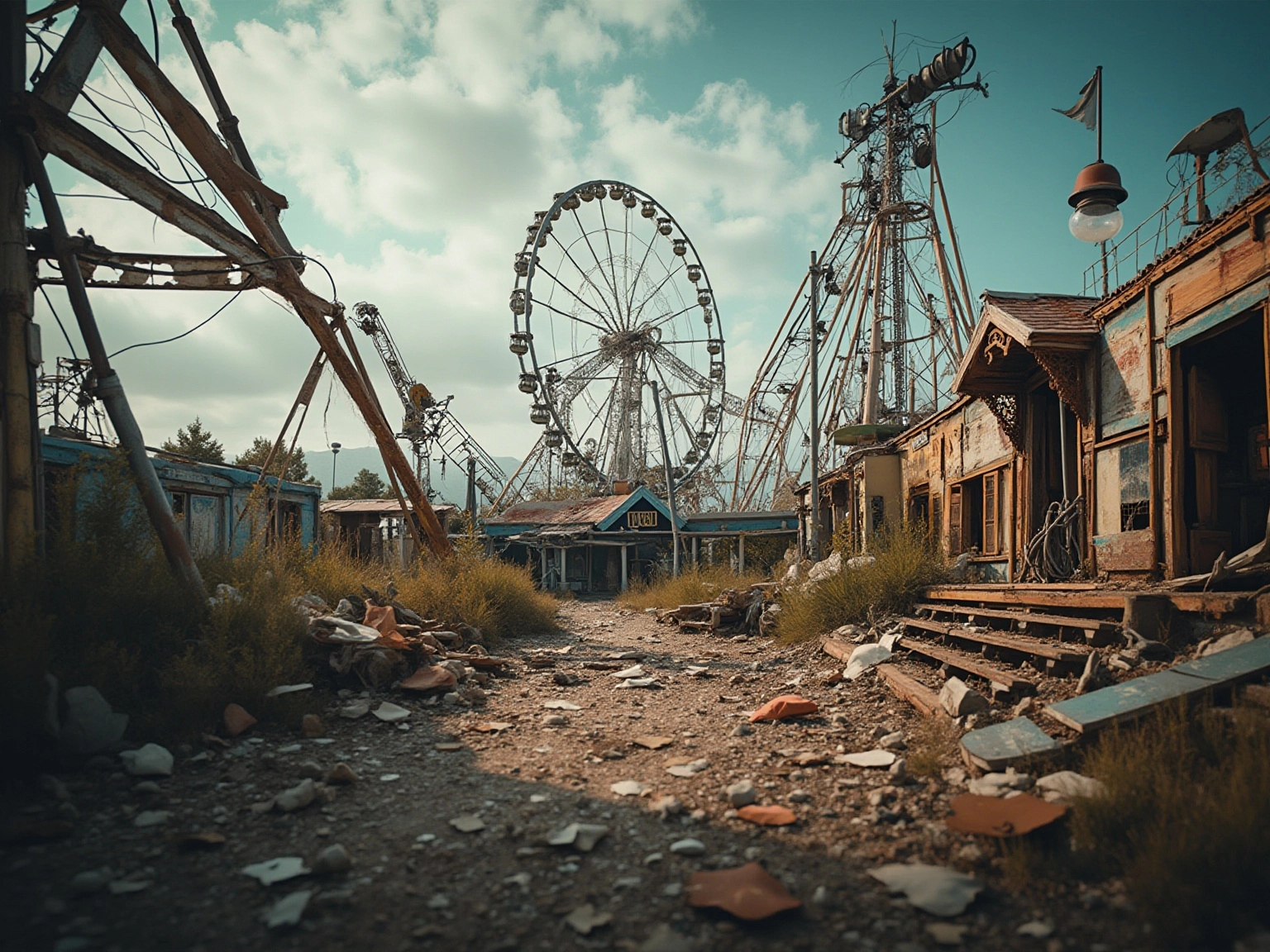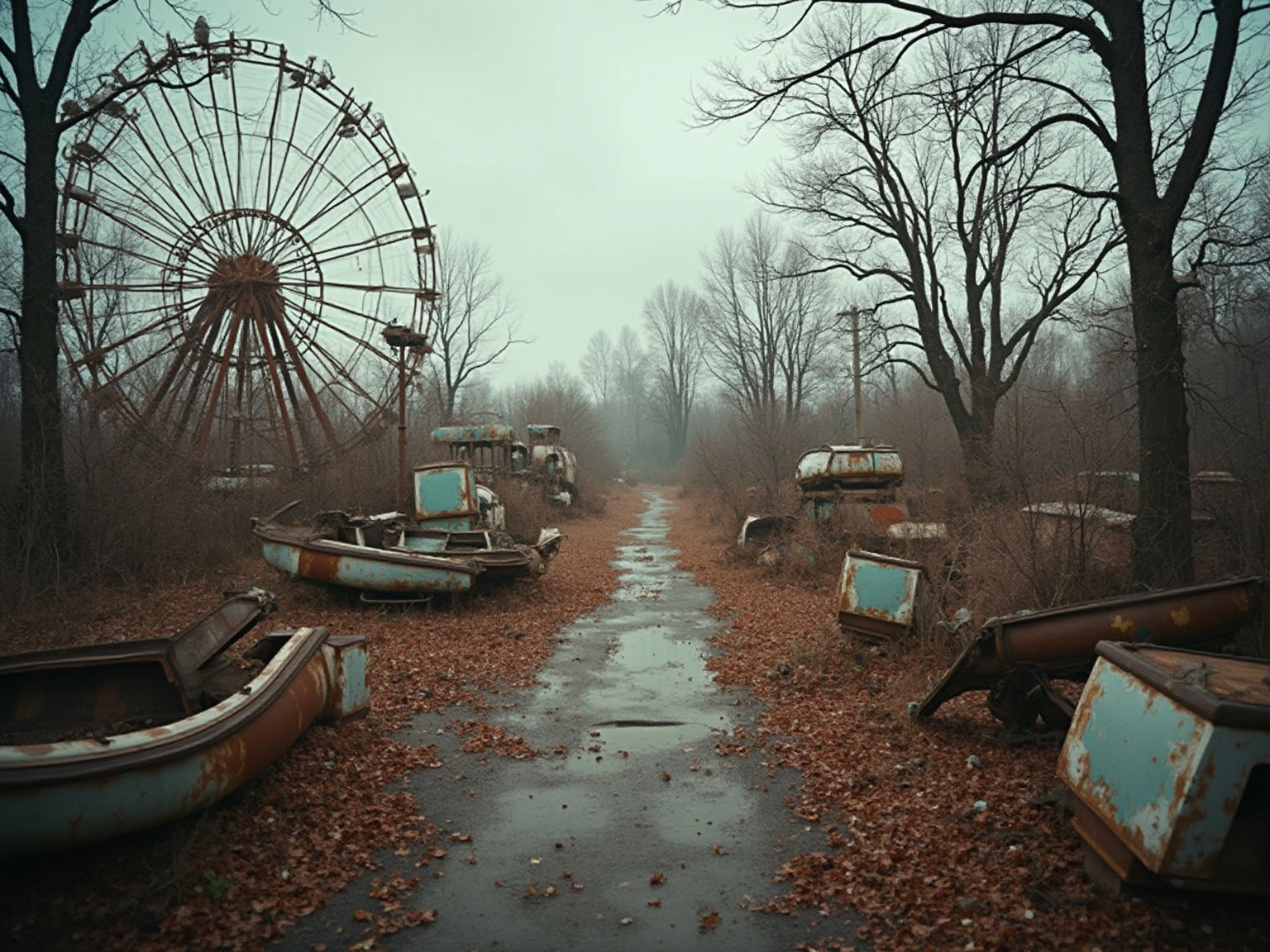Overview
Exploring abandoned amusement parks is a captivating adventure that combines nostalgia with the thrill of discovery! You’ll uncover stories that reveal societal values and the fleeting nature of joy. These sites not only evoke powerful emotional connections and reflections on past happiness, but they also highlight the importance of preservation efforts. Such efforts can breathe new life into local economies and foster a vibrant community identity. Isn’t that exciting? So, let’s dive into this fascinating world together!
Key Highlights:
- Abandoned amusement parks evoke nostalgia and intrigue, serving as reminders of joy that has faded into decay.
- Urban exploration has gained popularity, with about 1.5 million enthusiasts in the U.S., but it carries risks, as highlighted by a tragic incident in 2021.
- The decline of amusement parks often reflects economic downturns, shifting consumer preferences, and natural disasters, such as Hurricane Katrina’s impact on Six Flags New Orleans.
- Photographers find inspiration in the haunting beauty of these sites, with about 30% specializing in capturing abandoned locations.
- Exploring these parks offers a blend of thrill and emotional connection to the past, but safety precautions are essential due to potential dangers.
- The decline of entertainment venues mirrors broader societal trends and consumer behavior, emphasizing the need for unique experiences.
- Preservation efforts can revitalize local economies, with communities seeing a 20% increase in tourism through active preservation programs.
- The emotional journey of exploring these parks enhances mental health and fosters connections to personal histories.
- Abandoned amusement parks tell stories about societal values and the fleeting nature of happiness, prompting critical reflections on urban decay and consumerism.
- Top abandoned parks include Pripyat Amusement Area, Six Flags New Orleans, and Spreepark, each with unique historical significance.
Introduction
Abandoned amusement parks evoke a haunting sense of nostalgia, standing as silent witnesses to joy that has long since faded. These once-thriving sites, now enveloped in decay, invite you—adventurers and photographers alike—to explore the stories etched into their rusting rides and overgrown pathways.
As urban exploration gains momentum, a growing community is captivated by the allure of these forgotten places, each with its own unique narrative shaped by time and circumstance. Just think about it! From the remnants of Six Flags New Orleans, submerged by a natural disaster, to the eerie charm of Pripyat’s Ferris wheel, these locations not only reflect societal shifts but also challenge explorers to confront the delicate balance between adventure and safety.
The journey through these abandoned spaces becomes a poignant reflection on the passage of time, the impermanence of happiness, and the cultural legacies that continue to resonate within their walls. So, are you ready to uncover the stories waiting for you in these enchanting ruins?
Discovering the Allure of Abandoned Amusement Parks
Abandoned amusement parks evoke a sense of nostalgia and intrigue, serving as poignant reminders of joy that has faded into decay. Once vibrant with laughter and excitement, these parks now stand in eerie silence, beckoning you to delve into their forgotten stories. The allure of these locations lies not only in their haunting beauty but also in the rich histories they encapsulate, making them a captivating subject for city explorers and photographers alike.
In recent years, urban exploration has gained traction, with an estimated 1.5 million enthusiasts in the United States alone! People are drawn to the thrill of uncovering hidden gems and forgotten spaces. However, this pursuit isn’t without its dangers; in September 2021, a tragic incident occurred when a 34-year-old YouTuber suffered a fatal fall while filming in a deserted building in Moscow. This highlights the importance of safety precautions in this adventurous endeavor. The emotional impact of deserted entertainment venues is especially potent; they bring to mind recollections of carefree childhood moments and the fleeting essence of happiness.
As one expert notes, exploring these sites taps into a collective nostalgia, allowing you to reflect on the passage of time and the stories that linger in the shadows.
The narratives behind these areas are often as captivating as their physical remnants. Each site has its own story, shaped by the dreams and aspirations of those who once frequented them. Take, for instance, the now-defunct Six Flags New Orleans, which was submerged during Hurricane Katrina. It stands as a testament to nature’s power and the impermanence of human endeavors.
Such locations not only offer a glimpse into the past but also serve as a canvas for photographers seeking to capture the juxtaposition of beauty and decay. As city exploration continues to evolve, the fascination with abandoned amusement parks remains strong. In 2025, these parks are expected to attract even more attention, with explorers and photographers eager to document their haunting allure. But remember, it’s essential to approach these adventures with caution, as the risks associated with city exploration can be significant.
Offenstadt emphasizes that while these sites represent new territories of freedom, safety precautions are paramount. We want the thrill of discovery, but not at the expense of personal safety.
Moreover, the discourse surrounding urban exploration privileges certain bodies while marginalizing others, raising questions about rights to the city. As Bondi and Rose state, “Until women enjoy the same choices as men to act as the flaneur in contemporary cities, gender inequalities in rights to the city will persist.” This critical perspective adds depth to the narrative, reminding us that the exploration landscape is not just about adventure but also about inclusivity and representation.
Ultimately, exploring abandoned amusement parks is not merely about the excitement of the search; it’s about connecting with history and understanding the stories that shape our cultural landscape. These sites invite you to reflect on the joy they once provided and the stories they continue to tell, making them a rich tapestry for those willing to explore their depths.

The History Behind the Abandonment: Why These Parks Were Left Behind
Have you ever wondered why so many entertainment venues have disappeared? It’s a mix of economic downturns, shifting consumer preferences, and the harsh impact of natural disasters. Take Six Flags New Orleans, for instance. After Hurricane Katrina, it was left in disrepair, showcasing how environmental factors can dramatically reshape our leisure landscape. Across the country, recreational areas have faced declining attendance and rising operational costs, leading to closures that mirror broader societal trends.
Historically, the entertainment venue industry has faced some tough challenges. Over the last decade, statistics reveal a concerning trend: many recreational areas have closed their gates, struggling to meet the evolving demands of consumers who crave unique and immersive experiences. This shift has been intensified by economic pressures, as the outdoor recreation economy experienced an impressive inflation-adjusted GDP increase of 18.9% in 2021, while the overall U.S. economy grew by just 5.9%.
These figures highlight the resilience of outdoor activities, yet they also point to the vulnerabilities of traditional entertainment venues that didn’t keep pace with innovation.
As Karen LeBlanc, the creator of The Design Tourist, puts it, “By combining expert storytelling with practical travel advice, The Design Tourist empowers readers to explore the world with a creative lens.” This perspective is especially relevant when we look at the stories behind abandoned amusement parks, which serve as poignant reminders of how fleeting leisure and entertainment can be. Experts note that the decline of entertainment venues often reflects larger economic narratives, where changing consumer preferences and external influences, like natural disasters, can lead to swift transformations.
The economic impact of these closures extends beyond the venues themselves, affecting local economies and communities that once thrived on the tourism and jobs these attractions provided. Notably, the entertainment venues industry’s revenue is assessed across various segments, with admissions, rides, and games being the largest contributors, making up the bulk of income from ticket sales.
So, the tales of deserted recreational sites encapsulate a complex interplay of economic forces, societal shifts, and the relentless passage of time. A case study titled ‘Economic Impact of Outdoor Recreation’ illustrates how the outdoor recreation economy showed remarkable resilience during the pandemic, standing in stark contrast to the challenges faced by traditional entertainment venues. This underscores the broader social trends that have led to the decline of entertainment venues, offering a more nuanced view of the factors at play.
Captivating Imagery: The Haunting Beauty of Abandoned Parks
The haunting beauty of abandoned amusement parks is vividly captured in photographs that showcase the striking contrast between nature and man-made structures. Overgrown rides, rusting attractions, and faded signage create a surreal landscape that evokes a sense of nostalgia and loss. Isn’t it fascinating how this aesthetic appeal of decay has become a focal point for many photographers? They find inspiration in the stories these forgotten places tell!
Photographers like Seph Lawless have gained acclaim for their evocative images, revealing the eerie charm of these sites. His work exemplifies how the interplay of light and shadow can transform dilapidated structures into hauntingly beautiful compositions. Have you noticed how the trend of city exploration photography has surged in popularity? More and more photographers are specializing in capturing the essence of abandoned locations.
Recent statistics indicate that about 30% of city photographers are now focusing on this niche, reflecting a broader interest in the narratives behind these decaying spaces. The allure of these abandoned amusement parks lies not only in their visual appeal but also in the emotional connections they evoke. As James Kerwin, a photographer known for his work in this genre, notes, “I find it both challenging and rewarding, and it will enable me to take my portfolio up a level and appeal to more people.” This sentiment resonates deeply with the ongoing evolution of urban exploration photography, especially as Kerwin’s upcoming projects in Portugal and Italy will further explore the themes of urban decay and landscape photography.
Adding to the contemporary context, De Rueda described his experience with Nikon as a dream project, despite the challenges of entering unfamiliar territories. This really underscores the complexities photographers face in this niche, as they navigate both the beauty and the challenges of capturing neglected spaces.
To successfully capture the essence of abandoned amusement parks, you need a keen eye for detail and an appreciation for the haunting beauty of decay. As photographers continue to push the boundaries of this genre, they invite you to reflect on the stories of neglect and the passage of time, ultimately enriching our understanding of these once-vibrant spaces. Notably, The Design Tourist has received the NATJA Gold and Bronze Awards for excellence in travel journalism, further establishing its authority in discussing the intersection of travel and photography.
The Thrill of Exploration: Adventures in Abandoned Spaces
Exploring abandoned amusement parks is such an exciting adventure, blending the thrill of discovery with hidden histories waiting to be uncovered! Urban explorers like you are often drawn to these forgotten spaces, navigating through rusting rides and crumbling facades. Each step you take echoes the laughter and joy that once filled these vibrant places. This journey not only satisfies your curiosity but also deepens your connection to the stories and memories embedded in these unique realms.
The thrill of venturing into the unknown is truly palpable! You might find yourself in awe of the artistry that remains, from intricate architectural details to the vibrant colors faded by time. Every visit to an abandoned amusement park becomes a nostalgic journey, revealing the cultural narratives that shaped these parks and the communities surrounding them.
However, it’s essential to approach these adventures responsibly. Did you know that city exploration can come with risks? Statistics show that accidents can happen in these often unstable environments. A dataset of 6,690 crash incidents highlights just how important safety awareness is in your explorations.
That’s why improving safety awareness and adopting best practices is crucial for thrill-seekers like you! By prioritizing safety, you can enjoy the excitement of discovering these unique locations while honoring the legacies they represent.
As Natalie Draisin, Director of the North America Office & United Nations Representative for the FIA Foundation, puts it, “The US prides itself on being a global leader. Yet there’s one way we’d rather not be leading—in the number of people dying on our roads.” This quote really drives home the urgency of addressing safety issues, resonating with the theme of preserving the legacies of abandoned amusement parks.
Adventure stories from fellow explorers often highlight the emotional highs of these experiences, where the thrill of discovery intertwines with a profound respect for the past. As city exploration continues to captivate thrill-seekers, it also serves as a reminder of the importance of preserving these sites, ensuring that their stories aren’t lost to time. Just like proposed strategies to reduce fatal traffic accidents emphasize the need for improved practices among motorists, city explorers must also commit to responsible exploration to safeguard their adventures.

Essential Tips for Exploring Abandoned Amusement Parks Safely
Safety is paramount when you’re off exploring abandoned amusement parks! To ensure you have a secure and enjoyable experience, here are some essential tips to keep in mind:
- Buddy System: Always explore with a companion. Not only does this enhance your safety, but it also makes the adventure more enjoyable!
- Footwear Matters: Make sure to wear sturdy shoes to protect your feet from sharp objects and uneven terrain.
- Lighting is Key: Bring a flashlight to navigate dark areas and spot potential hazards.
- Stay Alert: Be mindful of your surroundings and steer clear of areas that show signs of structural instability, like crumbling walls or unstable floors.
- Respect Boundaries: Always respect private property. If the site is owned, be sure to seek permission before entering to avoid any legal issues and ensure a safer visit.
Statistics reveal that urban exploration can be risky. For instance, a tragic incident in September 2021 highlighted the dangers when a YouTuber suffered a fatal fall while filming in a derelict building. Ally Law, a YouTuber known for exploring deserted sites, shares that he can earn thousands of pounds per video showcasing his adventures, but these high-stakes explorations come with significant risks. Such events really highlight the necessity of sticking to safety protocols.
Additionally, it’s crucial to be aware of the legal implications of exploring unoccupied properties. Laws against trespassing and burglary can vary by jurisdiction, so understanding these regulations can help mitigate legal risks. Experts in urban exploration emphasize the importance of preparation and awareness.
By following these guidelines, you can reduce risks and fully immerse yourself in the unique experiences that abandoned amusement parks offer!
Cultural Reflections: What Abandoned Parks Tell Us About Society
Have you ever wandered through a deserted amusement park? These abandoned entertainment venues are not just relics; they embody the evolution of our societal values and stir up memories of our childhood. They evoke a whirlwind of emotions, prompting us to reflect on consumerism, urban decay, and the fleeting nature of happiness. As these once-vibrant places fade into neglect, they remind us of how quickly joy can slip away and how economic and social changes can reshape our leisure activities.
The decline of these amusement parks mirrors broader trends in consumer behavior. Often, the thrill of instant gratification overshadows the lasting joy found in shared experiences. Sociological studies reveal that nostalgia can have a powerful impact on our emotional well-being. Research shows that reminiscing about joyful moments can boost feelings of excitement and optimism, even if just for a little while. In fact, one study found that nostalgia can enhance feelings of enthusiasm for up to three hours, while slightly reducing calmness and relaxation. It’s fascinating how nostalgia plays with our emotions!
This duality of nostalgia—its power to uplift us while also stirring a sense of loss—highlights the complex bond between our memories and the cherished spaces of our past. But the significance of abandoned amusement parks goes beyond just nostalgia; they prompt us to think critically about urban decay and consumerism. As communities confront the remnants of these parks, they reflect on the societal shifts that led to their downfall, raising important questions about what these sites reveal about our collective values and priorities.
The stories hidden within the rusting rides and overgrown paths of these amusement parks offer a unique perspective on our past. They illuminate the intricate tapestry of human experience and the transient nature of joy in our ever-changing world. As noted by Sedikides et al., nostalgia is primarily a positive feeling, emphasizing the emotional complexity tied to these deserted venues. This aligns beautifully with the blog’s focus on creativity and connection, as these sites inspire reflection and artistic interpretation, inviting you to delve into the deeper narratives of your own past.

Top 10 Must-Visit Abandoned Amusement Parks Around the World
- Pripyat Amusement Area, Ukraine – This site serves as a haunting reminder of the Chernobyl disaster, left abandoned since 1986. Its iconic Ferris wheel, now rusted and overgrown, symbolizes the abrupt halt of joy in a once-vibrant community. It invites you to reflect on the stories of loss and resilience.
- Six Flags New Orleans, USA – A ghostly remnant of a once-flourishing entertainment venue, Six Flags New Orleans has been overtaken by nature since its closure in 2005 due to Hurricane Katrina. The eerie atmosphere and decaying rides provide a glimpse into what was once a bustling entertainment hub, embodying the narrative of a city’s struggle and recovery.
- Spreepark, Berlin, Germany – This former East German amusement area, operational from 1969 until 2001, is rich in history and unique attractions. Its deserted rides, including the iconic Ferris wheel, tell stories of a bygone era. It’s a fascinating site for urban explorers seeking to understand the cultural shifts of the time.
- Gulliver’s Kingdom, Japan – Featuring giant replicas of famous characters, this abandoned amusement area has fallen into disrepair since its closure in 2001. The whimsical structures, now weathered and overgrown, evoke a sense of nostalgia and wonder. They reflect the cultural impact of storytelling through design.
- Lake Shawnee Amusement Area, West Virginia, USA – Known for its eerie history and ghost stories, this site has been closed since the 1960s. Visitors often report strange occurrences, adding to its reputation as a haunted site. It’s a must-see for thrill-seekers drawn to the narratives of the past.
- Wonderland, Beijing, China – This massive, unfinished amusement area stands as a testament to unrealized dreams. Construction began in 1998 but was halted in 2000, leaving behind a sprawling site filled with incomplete attractions. It invites reflection on the aspirations of a society.
- Taman Festival, Bali, Indonesia – Once a vibrant cultural area, Taman Festival has succumbed to decay since its closure in 2000. The remnants of its colorful attractions and performances now serve as a poignant reminder of the island’s rich cultural heritage. It emphasizes the importance of preserving stories through design.
- Dinosaur Land, Arkansas, USA – Filled with quirky dinosaur sculptures, this area has been left to the elements since its closure in the 1990s. The whimsical figures, now weathered and fading, continue to attract curious visitors and photographers. They showcase the playful side of cultural storytelling.
- Land of Oz, North Carolina, USA – Inspired by the Wizard of Oz, this whimsical attraction has become a shadow of its former self since closing in 1980. Its enchanting landscapes and remnants of attractions evoke a sense of magic and nostalgia for those who remember its glory days. It highlights the enduring power of narrative in design.
- Joyland Amusement Park, Kansas, USA – A nostalgic site filled with vintage rides, Joyland has been closed since 2004. Its charming attractions and retro vibe make it a beloved memory for many locals, despite its current state of abandonment. It illustrates how design can evoke personal and collective memories.
The worldwide fascination with abandoned amusement parks keeps expanding, as many travelers explore these distinctive sites for their rich histories and eerie atmospheres. As immersive and experiential entertainment trends rise, these parks offer a captivating view into the past, inviting exploration and reflection. As Karen LeBlanc, a travel host and writer for The Design Tourist, states, “By combining expert storytelling with practical travel advice, The Design Tourist empowers readers to explore the world with a creative lens.”
This ethos reflects the exploration of these neglected sites, where the stories of their pasts enhance the travel experience. Furthermore, the case study on regional differences in entertainment ride safety emphasizes the significance of comprehending the historical context of these venues. The statistic concerning Plutón Venue, which functioned from 1997 to 2002, acts as a tangible example of the numerous narratives awaiting discovery in these overlooked locations.
Share Your Stories: Engaging with the Community of Explorers
Urban exploration thrives on the power of shared experiences, creating a vibrant community of enthusiasts who dive into the stories behind abandoned amusement parks. You’re invited to contribute your own narratives, photos, and insights—whether you recount thrilling adventures or eerie encounters! These personal accounts not only enrich our collective knowledge but also foster a deeper appreciation for the beauty and history of these forgotten sites.
Interacting with fellow adventurers is as easy as joining online forums or social media groups focused on urban exploration. These platforms are fantastic resources for exchanging tips, sharing tales, and connecting with like-minded individuals! It’s exciting to note that city exploration communities have seen a notable rise in social media engagement, especially during the pandemic, as many sought new ways to connect and share their experiences.
In fact, the average number of monthly reviews during the lockdown was slightly higher than in regular months, showing a growing interest in this niche.
Case studies highlight the importance of community involvement in city exploration. For instance, research on city parks in Bucharest, Romania, reveals that visitor perceptions evolve over time, reflecting a growing interest in multifunctional spaces. This shift underscores the need for city explorers to share their experiences, as these stories can influence how communities view and engage with neglected locations.
As Karen LeBlanc, creator of The Design Tourist, puts it, “By combining expert storytelling with practical travel advice, The Design Tourist empowers readers to explore the world with a creative lens.” By participating in this dialogue, explorers not only document their journeys but also contribute to a larger narrative that celebrates the artistry and history embedded in these locations. However, it’s crucial to approach urban exploration with caution; a tragic incident in September 2021, where a 34-year-old YouTuber suffered a fatal fall while filming in an unoccupied building in Moscow, serves as a stark reminder of the potential dangers involved.
The tales exchanged within this community can inspire others to embark on their own adventures, ensuring that the legacy of the abandoned amusement parks continues to resonate. So, share your experiences and insights on social media to connect with fellow explorers and keep the conversation alive!
Preserving the Past: The Importance of Protecting Abandoned Parks
Maintaining abandoned amusement parks is crucial for protecting our cultural heritage and history! These unique sites serve as tangible reminders of past societal values and leisure practices, offering you a fascinating glimpse into the evolution of entertainment and community life. Revitalizing these areas not only honors their historical significance but also fosters a sense of pride and identity within local communities.
You might be surprised to learn that initiatives aimed at safeguarding and rejuvenating these recreational spots can lead to economic revitalization! They attract visitors eager to discover their rich stories. For instance, statistics show that communities with active preservation programs enjoy a 20% increase in local tourism. That’s a fantastic boost, highlighting the economic benefits of such endeavors. When locals engage in preservation efforts, they not only enhance the physical landscape but also strengthen communal bonds.
Advocacy for preservation can take many forms—supporting local initiatives, participating in clean-up efforts, and raising awareness about the significance of these unique locations are just a few! Take the ongoing research in Poggioreale, for example. It demonstrates the importance of community memory and the intangible values linked to neglected sites. This project emphasizes the need for educational interventions that guide visitors in understanding the history and lives of former inhabitants, ultimately aiming to recover and preserve the collective memory of the community.
Expert opinions underscore the necessity of protecting these cultural heritage sites. Preservationists argue that abandoned amusement parks are not just remnants of history; they are essential elements of our collective past that deserve our attention. As one observer noted, “The towns of Gibellina, Salaparuta, Poggioreale, and Montevago have suffered total destruction, and all that remains of them is a shapeless heap of rubble, twisted beams, and crumbling walls.”
By championing these efforts, we can ensure that future generations appreciate the stories and experiences embedded within these once-vibrant spaces. So, what can you do to help? Let’s explore ways to get involved and make a difference together!
Reflections on Adventure: The Emotional Journey of Exploring Abandoned Parks
Exploring abandoned amusement parks is more than just an adventure; it’s a profound emotional journey that stirs up nostalgia, curiosity, and a touch of melancholy. Every visit feels like a portal to childhood memories, reminding you of the joy found in simpler times and the inevitable passage of life. As you wander through these deserted parks, you might find yourself reflecting on the fleeting nature of happiness and the untold stories that linger in the quiet.
This exploration not only rekindles cherished memories but also deepens your appreciation for the past and the invaluable lessons it brings. The emotional impact of these experiences can be truly transformative, allowing you to connect with your own history while contemplating the broader narratives of joy and loss that shape our shared human experience. Interestingly, studies suggest that nostalgia linked to these sites can significantly enhance mental health, fostering a greater sense of well-being and connection to your personal history.
For instance, the third city environmental profile was tied to thirteen regional brain volumes, hinting at a complex relationship between city environments and psychological responses. Plus, as Qiyan Li from the Institute of Geography highlights, future studies should embrace a diverse range of participants to better understand the emotional reflections that come with urban exploration. This is especially relevant considering the analysis of anxiety symptoms, which found that environments rich in infrastructure and leisure spaces often correlate positively with anxiety, while being close to natural areas can offer protective benefits.
In this light, city exploration becomes a meaningful engagement with both the physical and emotional landscapes of our lives. It underscores the importance of well-developed traffic signage systems in commercial areas to enhance your overall experience. Additionally, moderated mediation analysis has revealed that certain genes may influence emotional responses during urban exploration, adding a fascinating scientific layer to the emotional reflections we experience. By weaving these insights into our narrative, we can truly appreciate the intricate connections between our surroundings and our emotional well-being.
Conclusion
Abandoned amusement parks are like time capsules, reminding us of the joy and excitement of a bygone era. They invite you to explore the stories of laughter that once filled their spaces, sparking a rich sense of nostalgia. When you venture into these sites, it’s not just about the thrill of adventure; it’s also a chance to reflect on how society has changed, how economies shift, and how fleeting happiness can be.
The decline of these parks often tells a bigger story, shaped by economic downturns and changing consumer tastes. Each abandoned site—from Six Flags New Orleans to the haunting beauty of Pripyat’s Ferris wheel—holds a unique history that encourages us to think about our values and the impermanence of leisure. As urban exploration becomes more popular, it’s crucial to prioritize safety and responsible exploration. The excitement of uncovering hidden histories comes with risks, so being cautious and prepared is key.
Ultimately, exploring these abandoned amusement parks can deepen your understanding of the past and create a connection to the stories that linger within their walls. As the community of urban explorers grows, sharing your experiences and insights adds richness to the collective narrative. This way, the legacies of these enchanting ruins remain vibrant. By embracing both the thrill of adventure and the responsibility of preservation, you contribute to a meaningful dialogue about the cultural significance of these forgotten spaces, honoring the joy they once brought and the lessons they offer for future generations.
Frequently Asked Questions
What is the appeal of abandoned amusement parks?
Abandoned amusement parks evoke nostalgia and intrigue, serving as reminders of joy that has faded into decay. They are captivating for city explorers and photographers due to their haunting beauty and rich histories.
How has urban exploration changed in recent years?
Urban exploration has gained popularity, with an estimated 1.5 million enthusiasts in the United States. People are drawn to uncover hidden gems and forgotten spaces, although this pursuit can be dangerous.
What are some safety concerns associated with urban exploration?
Urban exploration can pose significant risks, as highlighted by a tragic incident in September 2021 when a YouTuber fell while filming in a deserted building. Therefore, safety precautions are essential during these adventures.
What emotional connections do abandoned amusement parks evoke?
These sites remind visitors of carefree childhood moments and the fleeting essence of happiness, tapping into a collective nostalgia and allowing reflection on the passage of time.
Can you provide an example of a notable abandoned amusement park?
Six Flags New Orleans is a notable example, as it was submerged during Hurricane Katrina, showcasing the impact of natural disasters on entertainment venues.
What role do photographers play in capturing the essence of abandoned amusement parks?
Photographers specialize in documenting these locations, using their work to highlight the contrast between beauty and decay. Their images often evoke emotional connections and tell the stories of neglect.
How has the trend of city exploration photography evolved?
Approximately 30% of city photographers now focus on capturing abandoned locations, reflecting a growing interest in the narratives behind these decaying spaces.
What factors have contributed to the decline of entertainment venues?
Economic downturns, changing consumer preferences, and natural disasters have led to many entertainment venues closing, as seen with Six Flags New Orleans after Hurricane Katrina.
How do abandoned amusement parks reflect broader societal trends?
The decline of these venues mirrors larger economic narratives, highlighting vulnerabilities in traditional entertainment that didn’t adapt to changing consumer demands and external influences.
What is the significance of exploring abandoned amusement parks?
Exploring these sites is not just about the thrill of discovery; it connects individuals with history and the stories that shape our cultural landscape, inviting reflection on joy and loss.


































